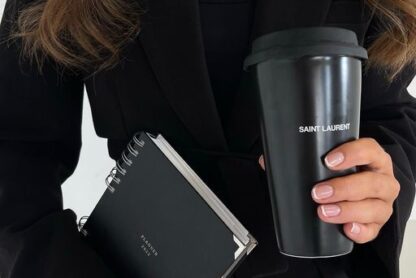Fashion marketing is a profession that includes a wide range of responsibilities. If you’ve ever thought that it’s all about creating catchy campaigns, there is a lot of research and analysis that needs to be done previously to reach this result.
There are many metrics used in fashion that marketers have to analyze to influence their marketing decisions. If you are considering a career in fashion marketing or you are currently working in this field and want to be better at your job, you should know these fashion marketing terms. The knowledge of the terms related to your role is indeed one of the things that makes a great professional. So if you are here, this is a sign that today is the day to give your career a boost 😉
Fashion Marketing Terms
1. Brand Identity
Brand identity encompasses all the visible elements of a brand that distinguish and identify the brand in consumers’ minds. This includes everything from the logo, colors, design, materials, typography, and iconography to the overall aesthetic and values conveyed through marketing efforts. For example, when you see a Hermès orange box, Chanel’s Camelia, or Burberry’s check, you can probably instantly recognize those brands.
Fashion branding is what can make a consumer shift from wanting to buy one product to purchasing another one in the end because it resonates more with them. Therefore, building a brand identity is a crucial task in fashion marketing.
2. Brand Equity
Brand equity refers to the value a brand adds to a product or service. It’s the perception of the quality and emotional connection consumers have with a brand, which can lead to customer loyalty and higher sales.
3. Target Market
The target market is a specific group of consumers at which a company aims its products and services. It is defined by age, gender, and income level, as well as demographic, geographic, behavioral, and other characteristics. In fashion marketing, understanding the target market is crucial for creating effective campaigns and designing collections that meet their preferences and needs.
4. Segmentation
Segmentation involves dividing a broad consumer or business market (from the big target market) into sub-groups based on shared characteristics. This helps fashion brands tailor their marketing efforts to specific segments, such as age, gender, income, or lifestyle.
5. Consumer Behavior
Consumer behavior is a study that examines how individuals make decisions to spend their resources on consumption-related items. For fashion marketers, understanding consumer behavior helps in predicting trends, creating targeted marketing strategies, and improving customer satisfaction.
6. Positioning
Positioning is the process of establishing a brand or product in the consumer’s mind relative to competitors. In fashion, positioning involves creating a unique image and identity that resonates with the target audience.
7. Value Proposition
A value proposition is a promise of value to be delivered to the customer. It’s the primary reason a prospect should buy from you. In fashion marketing, it highlights the benefits and unique features of a brand or product that set it apart from competitors.
8. Competitor Benchmarking
Competitor benchmarking involves comparing a fashion brand’s performance metrics with those of its key competitors. This analysis includes thorough research and comparison of product categories, styles, prices, and marketing initiatives. The latter is especially useful to take into account for fashion marketers to create innovative campaigns and stand out.
Competitor benchmarking thus helps brands identify strengths, weaknesses, and opportunities for improvement relative to their rivals.
9. Sell-Through Rate (STR)
The sell-through rate measures the percentage of inventory that is sold within a specific period of time. A higher sell-through rate indicates strong demand and effective inventory management, while a lower rate may suggest slow sales or overstocking.
Knowing the sell-through rate helps fashion marketers adapt their marketing strategies to in-demand and less popular products.
10. Customer Lifetime Value (CLV)
Customer Lifetime Value (CLV) is a prediction of the net profit attributed to the entire future relationship with a customer. It takes into account factors such as the average purchase value, purchase frequency, and customer retention rate.
In fashion marketing, CLV helps brands understand the long-term value of their customers identify best-selling products, and tailor marketing strategies accordingly to increase customers’ interest and boost sales.
11. Customer Journey Mapping
Customer journey mapping is the process of visualizing the steps a customer takes from awareness to purchase. In fashion marketing, understanding the customer journey helps brands create targeted strategies to enhance the shopping experience and drive conversions.
12. Fashion Marketing Mix: The 4 Ps in Fashion
The fashion marketing mix, which includes Product, Price, Place, and Promotion and is often referred to as the 4 Ps, is a fundamental framework that helps fashion brands develop effective marketing strategies. Understanding and effectively leveraging the 4 Ps: Product, Price, Place, and Promotion, can significantly enhance a brand’s success in the competitive fashion industry.
13. Customer Acquisition Cost (CAC)
Calculates the average cost of acquiring a new customer. It includes marketing expenses, advertising costs, promotional campaigns, sales team salaries, and other expenditures related to gaining new customers. Lower CAC indicates more efficient marketing. It thus helps assess marketing strategies and modify them if needed.
14. Net Promoter Score (NPS)
In the fashion industry, the net promoter score is a metric that helps assess customer loyalty and satisfaction, helping brands understand how their customers feel about their products, quality, price, and overall shopping experience. by asking how likely customers are to recommend the brand to others.
A high NPS indicates strong customer satisfaction and positive word-of-mouth, which brings a competitive edge to the brand and makes it responsive to customer needs in a dynamic fashion industry.
15. Average Order Value (AOV)
The Average Order Value is one of the most important key performance indicators used by companies to understand their customers’ purchasing habits. It represents the average amount of money spent by customers per transaction on the brand’s e-commerce. Increasing AOV indicates successful upselling and cross-selling strategies.
Fashion marketers need to consider the AOV to improve the customers’ purchasing habits, as the shopping experience encompasses a wide range of factors outside of the product attractiveness and quality itself, such as catchy visuals and product descriptions.
16. Inventory Turnover Rate
Measures how often inventory is sold and replaced over a specific period, typically a year. In fashion, the inventory turnover rate provides insights into how well a fashion brand or retailer is managing its inventory in relation to its sales, balancing supply and demand. A high turnover rate indicates efficient inventory management and strong product demand.
Knowing the inventory turnover rate is crucial in a fast-paced fashion industry, and can help brands adapt to market trends.
17. Market Share
Represents the percentage of brand’s or retailer’s sales within a given period of the total market sales aka generated by all fashion brands within the same market (for example fashion) during that period.
Comparing market share helps benchmark their performance relative to competitors, and identify their strengths and weaknesses. Fashion marketing specialists can use the data of market share to set strategies to better differentiate the brand and its products, and create campaigns that resonate with the target audience, drive sales, and have a stronger position in the market overall.
18. Ad Impressions
Ad impressions refer to the number of times an ad is displayed to users across various channels, such as digital platforms, social media, websites, and billboards. High impressions indicate broad reach, but it should be analyzed alongside engagement metrics to evaluate effectiveness.
Ad impressions are a key metric for fashion marketers to measure the effectiveness of their ad campaigns, tailor them to reach the target market more efficiently and influence further creative content to grow the brand’s online/offline visibility.
19. Return Rate
The return rate refers to the percentage of products returned by customers after purchase. A high return rate may indicate issues with product quality, sizing, or customer expectations.
The return rate is a key metric in fashion because it has a direct impact on profitability, inventory management, customer satisfaction, and operational efficiency from customer service and logistics to warehousing. The marketing and communication teams can contribute to creating high-quality, detailed visuals and product descriptions that can help customers make informed decisions and reduce returns.
20. Brand Sentiment Analysis
Analyzes the overall sentiment of customers’ attitudes, opinions, and feelings toward a fashion brand. This data can be gathered through reviews, social media mentions, feedback forms, and press coverage. Positive sentiment indicates strong brand perception, while negative sentiment may highlight areas for improvement.
Understanding customer sentiment is everything in fashion marketing to conceive effective messages that resonate with the audience.
21. User-Generated Content (UGC) Engagement
Tracks engagement metrics related to content created by customers, such as reviews, photos, and social media posts. High UGC engagement indicates strong customer advocacy and brand loyalty. UFC in fashion is a powerful tool used by marketing specialists to engage with customers in a more authentic and interactive way and build their trust. In addition, UGC can help reduce the costs associated with content creation and additional spending on ads as users can create the content themselves and share it across their networks.
22. Seasonal Sales Performance
Tracks sales performance during specific seasons or fashion cycles. In fashion, where sales can fluctuate significantly depending on the time of year, tracking seasonal sales performance helps understand consumer behavior and assess the effectiveness of seasonal marketing campaigns and product assortments, as well as optimizing inventory and maximizing revenue.
23. Omnichannel Marketing
Omnichannel marketing involves creating a seamless shopping experience across multiple channels integrating online and offline experiences, aka in physical stores, e-commerce, social media, and mobile apps. It’s about creating a consistent and personalized brand experience for customers, no matter where or how they choose to interact with the brand. Measuring these data analytics helps fashion marketers to understand customer behavior across different touchpoints and align their marketing efforts accordingly.
24. Brand Ambassador
A brand ambassador is a person, often a celebrity or influencer, who represents and promotes a fashion brand as a whole or its specific product. Think Rihanna for Dior J’Adore, Jacob Elordi for Bottega Veneta, and Blackpink’s Lisa for Louis Vuitton. The role of fashion brand ambassadors is to embody the brand’s values and image, increasing brand awareness and credibility. They thus play a vital role in fashion marketing.
25. Content Marketing
Content marketing involves creating and distributing valuable, relevant content to attract and engage a target audience. In fashion, this includes blog posts, newsletters, videos, and social media content that showcase the brand’s story, values, and products.
26. Licensing Agreement
Licensing in fashion refers to the practice of allowing other companies to use a brand’s name, logo, design, or other trademark in exchange for royalties or licensing fees. Brands look for a third party – a retailer or conglomerate specializing in the distribution of a certain product category – to manufacture and distribute these products under the brand’s name. Licensing enables brands to expand into new product categories or markets without directly managing production.
For example, EssilorLuxottica produces Chanel sunglasses under a licensing agreement. Many beauty lines also operate under licensing agreements, like with Coty which produces the beauty line and fragrances of Burberry, Tiffany & Co., and Gucci.
27. Brand Extension
Brand extension is the practice of using an established brand name to launch new products or lines. For example, a fashion brand known for clothing might extend into accessories, beauty, home goods, or even hospitality (Giorgio Armani hotels), restaurant (Prada Café), and entertainment (Saint Laurent Productions) businesses.
In recent years, fashion companies have been extending a lot of their activities beyond fashion by opening spa salons, beach clubs, cafés, etc. Indeed, brand extension allows them to tap into new industries to offer a more complete lifestyle to their customers and reach new clients with different budgets. For example, while luxury ready-to-wear is not accessible to everyone, people with lower budgets can afford to have a meal at a luxury brand’s restaurant.
How many new fashion marketing terms did you learn today?
If you want to learn more terms used in fashion, take a look at these 30 common terms used in the industry, the fashion journalism glossary, fashion design terms, and the fashion week lingo.
Follow us on Instagram for more updates!







